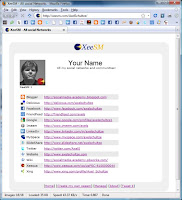I get more and more of the very same question: “Axel, I finally decided to get into the social media thing, do you have some advice?”
OK – too long ago I started from scratch, so everybody please chime in and add to it.
1) Give your engagement a purpose (other than just trying it out or selling something). For instance: You may want to learn more about your customers, you may want to help others in an area of your expertise, you may want to know more about your partners, you may want to learn what issues your customers have, you may want to learn from others about an area where you feel you are rather weak… Again don’t sell and don’t be as boring as “expand my network”.
2) Start on two places: let’s say LinkedIn and Facebook. Create your profile by:
– Adding a picture of yours, don’t make it too special amongst the 6 billion you are unique enough as you are
– Add your real name, your real background. No need to hide anything – it is out there anyway.
– Be open, the more information you provide the approachable you appear.
3) Social networking is about connections, conversations, exchanging experience… Invite all your friends from your address book to join you in your engagement. Don’t select only 5 or 10 – don’t be shy, you may be surprised who else is already there for years. So invite them all. If you are not comfortable to invite 1,000 – they only get an invitation from one – YOU. Don’t embarrass any of your friends, contacts or alliances by not connecting with them.
4) In the next few days you may be busy with confirming invitations, thanking them that they connect and asking them for their experience. They may have good tips for you as well. Keep the dialog over the next few weeks – make sure you leverage the connection for conversations – not just as yet another address book.
5) Now look for some groups with interesting topics or interesting people. Don’t forget your purpose by selecting the groups. Sign up with 2 or three, get familiar with the conversations. If you like it chime in, if not you may as well just leave the group. Once in the group: Don’t sell but just develop your skills and help others develop their skills with what ever expertise you may have. You will see others trying to sell something – don’t imitate (we’ll get to that later).
6) You are now a few weeks into it. You may wonder how much time you spend with no results. If that is the case: Your conversations or your network may have not been in line with your purpose. Or you may wonder how many wonderful and helpful people you met in such a short period of time – great – you are right on track.
7) The selling and doing business with those people almost reach the melting point. When can you go out and do business, sell something take orders….? Give it some more time. The social web is like a secret society you don’t get to the secret in the first few levels.
8) By now you may feel good about exploring other places and spaces. You may want to signup with Twitter and follow conversations that are in line with your purpose. Search for specific terms and check the people out. Also here, invite the people who are relevant to you and your purpose and follow them. Forget all the hype around getting thousands of followers. You are here for a reason – people who collected stamps in the past collect followers now – I guess you are not one of them.
9) Other places may be of interest: Create a little clip on your laptop and post it on YouTube, upload your presentations on SlideShare, store your bookmarks on Digg. You may find a few other interesting tools based on recommendations from friends. By now you do a lot of things and use a lot of tools based on recommendations from friends.
10) You are getting into the upper levels of the secret society. You learned a lot based on recommendations. You started tell others about your experience and recommend the tools to others. You retweet, write it to others on their wall… YOU NOTICE BY NOW: You never saw an advertising from LinkedIn or Twitter, you never received a cold call from any of the tools vendors you use. Nobody ever sold you something but you may already pay for some of the extras or reporting tools that help you follow your purpose. You may recognize: All it takes is recommendations. If somebody would have called you at home to use “Friends-or-Follower” you may have dropped it because thats the last thing you want.
11) As you join more groups you recognize the guys who ask hundreds of questions, answer the question right away and put a URL you should visit. Thousands of SEO and outsourcer try to sell you that way – and I’m sure like anybody else you just hate it. You reached an important point of understanding. Selling and advertising in the social web just doesn’t work. But you have this wonderful group of people who helped you and you helped them. And while you still want to do business, introduce your solutions and make a living you learned by now RECOMMENDATION is the currency in the business web. Recommendation = conversation, conducted by others. And maybe you experienced it already – other people recommend you and maybe even your business or products because what you produce or sell is helpful to somebody else.
12) You look back – probably 6 or more month passed by. You are proud that you made it through the maze of valuable and stupid information, through people you met and others you have known for many years. Your initial goals may be achieved and you feel good about the social web. Now you may take it to a whole new level – take your company and help the entire team to make sense out of all this. Make your team and your business partners a helpful hand to your customer base and your industry. Work with your customers and make them so happy that they RECOMMEND you. They can do that much better than you ever will in your life. When all the connections of all your team mates and partners recommend your products and services because they are helpful to others you become one of the top successful business person – without selling a thing.
 Axel Schultze MyXeeSM
Axel Schultze MyXeeSM





 Need a chance to express yourself?
Need a chance to express yourself? 